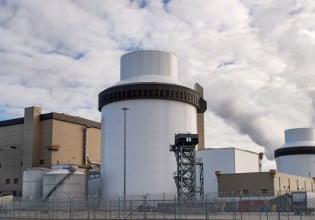Microgrid in a Box Provides Renewable Backup Power for Rural Areas
Engineers demonstrate a renewable energy-based mobile backup power system at a hydropower plant in rural Idaho.
Idaho National Laboratory (INL) recently unveiled its “Microgrid in a Box” concept at a rural hydropower plant. The researchers behind the project demonstrated how advanced controls and a self-contained mobile microgrid can restore and maintain electricity for essential services during blackouts and other emergencies.
Idaho National Laboratory engineers unveil a mobile microgrid to supply backup power for rural communities. Image used courtesy of INL
At Fall River Electric Coorperative’s hydropower facility in northeast Idaho, engineers simulated a power outage to demonstrate the microgrid’s ability to perform a “black start,” the process of restarting and restoring electricity for power generation units, transmission lines, and distribution networks in periods of disruption.
The microgrid system contains 320 kilowatt-hours (kWh) of battery storage and is hosted in mobile trailers and containers. It can seamlessly connect to the grid and distribute electricity to small towns, hospitals, transportation hubs, and other critical facilities. The system integrates and optimizes several renewable energy sources, including solar panels, wind turbines, small nuclear reactors, and conventional diesel generators.
The self-contained grid system can serve defense needs, and an early version was deployed for military use in Kuwait.
In addition to supporting power outage restoration, Microgrid in a Box is easy to disassemble and transport to remote or off-grid locations.
Self-Contained Microgrid Concept
The mobile microgrid–officially titled Relocatable Resiliency Alternative Power Improvement Distribution (RAPID MIB)–was developed in partnership with government and private entities. At a recent event, INL researchers demonstrated its functions in an outage simulation and black start process with around 70 people from government agencies, utilities, and companies in attendance.
Bryan Case, the CEO of Fall River Electric Cooperative, said the test supports the company’s ability to deploy a hydropower and battery system for restoring power to its members during natural disasters or other emergencies. The existing capabilities of its hydropower plant on Idaho’s Teton River can be combined with Microgrid in a Box to provide critical backup power for the surrounding rural community. The cooperative has over 14,000 owner-members and covers seven counties across Idaho, Montana, and Wyoming. Around 14% of the power used by its members is generated by four hydroelectric facilities, including the Teton River-based plant that hosted the microgrid demonstration.
Kurt Myers, who leads INL’s Energy and Grid Systems Integration team, said in February 2023 that the concept was initially designed for military applications, serving overseas bases with nonpermanent or semipermanent infrastructure. However, it also provides power outage restoration for essential services at the town/community level.
Since it’s easy to move and disassemble, Microgrid in a Box offsets the need for construction and lets engineers work with diesel generators or supplement them with renewables like solar, wind, and nuclear power.
An inside look at the Microgrid in a Box container. Image used courtesy of INL
INL claims RAPID MIB is a first-of-its-scale portable system with integrated advanced control functions and specifications. It can manage 250 kW of electricity and supports U.S. and U.K. standard electrical systems. Myers said the microgrid could power about two-thirds of the Center for Advanced Energy Studies building near INL’s campus in Idaho Falls, which requires about 350 kW on average.
The system hosts inverters that convert direct current voltage to alternating current (AC) voltage and power, and it’s capable of handling about 200 kW of AC-coupled generation from solar, wind, and nuclear resources and another 250 kW AC of fueled, synchronous generation.








